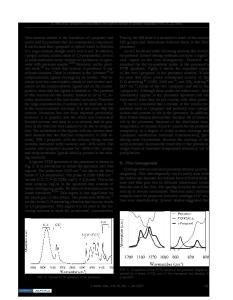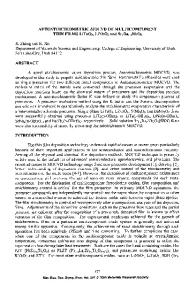Ba substituted Pb(Zr x Ti 1-x )O 3 thin films grown by MOCVD
- PDF / 416,777 Bytes
- 6 Pages / 595 x 842 pts (A4) Page_size
- 40 Downloads / 437 Views
0902-T04-06.1
Ba substituted Pb(ZrxTi1-x)O3 thin films grown by MOCVD Jochen Puchalla, Susanne Hoffmann-Eifert, Lorena Cattaneo1, Sergio Carella1, Rainer Waser Institute of Solid State Research and CNI—Center of Nanoelectronic Systems for Information Technology, Research Center Juelich, Juelich, D-52428, Germany 1 SAES Getters S.p.A. 20020-Lainate (Milano), Italy ABSTRACT Polycrystalline Pb(Zr,Ti)O3 [PZT] and (Pb1-yBay)(ZrxTi1-x)O3 (y ≤ 0.15, 0.25 ≤ x ≤ 0.50) [PBZT] thin films were grown on Pt (111) and Ir (111) coated silicon substrates by means of a pulsed liquid injection metal organic chemical vapor deposition (MOCVD) technique. The precursor solutions of Pb(DPM)2, Ba(DPM)2, Zr(IBPM)4, and Ti(OiPr)2(DPM)2 dissolved in butylacetate were separately injected into an AIX-200 reactor using a TriJetTM vaporizer. Stoichiometric films (0.98 ≤ A/B ≤ 1.06) with thickness between 85 and 150 nm were deposited at a susceptor temperature of 615 to 660°C. Contrary to PZT, an PbPtx alloy at the film / Pt interface was hardly observed for PBZT films with about 15 at% of Ba substitution. The polycrystalline PBZT films show a perovskite structure with a tendency for either a or a / preferred orientation of the grains. From XRD studies it is seen that a Ba substitution of 15 at% results in a clear shift of the tetragonal to rhombohedral phase transition towards lower Zr content. The ferro- and dielectric properties show a clear dependence on film composition and preferred orientation. In (Pb0.85Ba0.15)(ZrxTi1-x)O3 films with x = 0.35 (tetragonal) and 0.50 (rhombohedral), respectively, the coercive field Ec is highest for in comparison to textured films. For films of 85 nm thickness Pr is nearly orientation independent with values of 11 to 13 µC/cm2. The effective relative permittivity is strongly composition and orientation dependent. For tetragonal films εeff at room temperature changes from 405 to 540, and for rhombohedral PBZT films εeff changes from 715 to 890 with a change in the preferred orientation of the grains from to , respectively.
INTRODUCTION Lead zirconate titanate based thin films are gaining back relevance as storage layers in ferroelectric random access memories (FeRAMs). Integration relevant issues have increasingly successfully been solved for the perovskite-type tetragonal Pb(Zr1-xTix)O3 [PZT] system. Good compositional control over trench structures has recently been demonstrated for metal organic chemical vapour deposition (MOCVD) of PZT films by groups of T.I.Tech. and Samsung [1]. Although numerous studies were performed on MOCVD of PZT thin films [e.g. 2, 3], only a few deal with doping or substitution effects. In bulk samples Ba substitution results in a decrease of the ferroelectric phase transition temperature while at room temperature the tetragonal phase of (Pb,Ba)(ZrxTi1-x)O3 with x < 0.45 is sustained up to a Ba content of 0.50 [4]. In this paper we investigate the growth behaviour and the ferroelectric and dielectric properties of Ba substituted PZT thin films deposited on technically relevant me
Data Loading...











